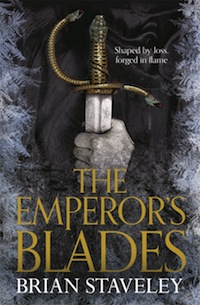Imagine you are a gardener. Even before the last bank of snow has leached into the mud, you’re outside hoeing up the dirt, preparing rows, pounding stakes for the peas and beans, stringing electric wire to keep out the deer. You plant the seeds—heirloom tomatoes and cucumbers, carrots that will grow to be thick as your fist, cabbages—then watch each day as the shoots shove up through the soil, stretch toward the sun, unfurl into blossom and leaf.
You water and weed, brush away the bright-winged beetles, turn the pumpkins and watermelons so they don’t flatten against the ground. And then, when the harvest is finally ready, you take your old flamethrower out of the barn, test the tank, light the pilot. Satisfied, you go back to the garden, look at all those beautifully laden plants, and then, in half an hour, you burn those fuckers right down to the ground. Writing a fantasy novel can be like that.
I mean, you know people are going to get hurt. They’re going to die. After a battle like Helm’s Deep or the Blackwater, the bodies are going to be piled up high as the eaves. Violence, with a bare handful of exceptions, is inextricably tied to the genre. Even in relatively bloodless books—say, A Wizard of Earthsea—there are deaths, dragons, the threat of ultimate annihilation. All very exciting for the reader, of course, but it feels a little different when you’re the one doing the annihilating.
By my quick and almost certainly incorrect count, fifteen with names die over the course of my first novel, The Emperor’s Blades. Seven of these deaths take place on-screen and in some detail. In every single case, my first thought as the axe flashed down, or the bow-string thrummed, or the knife tumbled end over end was: Maybe I can save this one. Snipers miss, after all. Axes glance off. If there are million ways to die, there just as many ways to avoid dying—the last-moment dive into the water, the locket that blocks the shot, the god who descends in a flaming chariot from between the clouds to pluck a favorite mortal from the fray. I want to save them! That’s what I always think while I’m cutting throats. It’s not too late!
That will sound soft, but it’s not that I’m soft. It’s that I’m lazy. I don’t want to give up something I worked so hard to create.
A character is at least as hard to grow as a tomato. Even the minor ones—that guardsman with the mole, the fat monk—they have pages and pages and pages of story behind them before they ever enter the book, pages that I write that never sees the light of day, documents filled with facts and backstory. This guy gets up eight times a night to pee. That one dreams of dead cattle for reasons she can’t remember. This would dance if it weren’t for his bunions. That one sings religious songs despite her lack of faith. And on and on.
As you fill the details in, you realize an interesting thing about fiction: any one of these characters could support a story. Maybe not an epic of world-shaking proportion, but a real story, with stakes and mistakes, hopes and failures, lies, recriminations, and redemption. Even that asshole standing over there with the halberd and the smirk on his face while the rest of the characters are moving the scene ahead—even he has a story. And because what writers do is tell the stories of their characters, I find myself wanting to explore the lives of all these people, even the ones standing off to the side. And then they have to die.
It’s inevitable, really. Mortality is built into the human condition, for one thing. More importantly, however, the minute a reader gets a whiff of the fact that you’ve gone soft as a writer, that you’re too lazy or in love with your own creations to lop off the odd head or send a few nightmare spider creatures over to devour someone’s bowels—the minute the reader believes you can’t really kill, you’re cooked. All tension seeps away, and what you’re left with, rather than drama, is a series of empty escapades, the coyote and roadrunner chasing each other around the desert for a few hundred pages until someone finds a magic sword and the whole thing gets wrapped up.
And so I kill these characters. Each time I kill one it feels like a waste, but—in a strange oxymoron—a necessary waste. I hate to destroy them, but then, it’s better than the neighbor calling the cops because I’m out in the cornfield with a flamethrower.
* * * * *
The Emperor’s Blades is now out in paperback, following hardback/ebook publication in the US and UK. Here are some more articles you might enjoy:
Lesson One: Burn it – Brian Staveley on how to be creative
Brian Staveley interview plus 7 free chapters of The Emperor’s Blades
After more than a decade teaching history, religion, and philosophy, Brian Staveley decided to write epic fantasy. He now lives on a steep dirt road in the hills of southern Vermont, where he divides his time between fathering, writing, husbanding, splitting wood, skiing, and adventuring, not necessarily in that order. He can be found on twitter at @brianstaveley, on Facebook as BrianStaveley, and on Google+ as Brian Staveley. His blog, On the Writing of Epic Fantasy, can be found at: bstaveley.wordpress.com.










